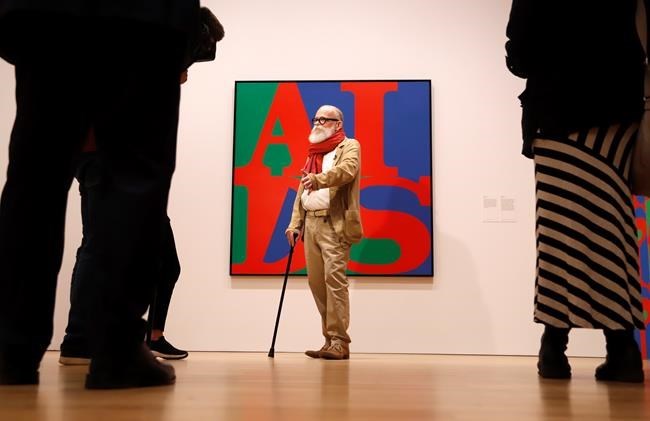
AA Bronson, the surviving member of the radical artist group General Idea, speaks with a reporter at an exhibition of their work at the National Gallery of Canada in Ottawa on Wednesday, June 1, 2022. THE CANADIAN PRESS/ Patrick Doyle
June 08, 2022 - 1:05 PM
When the group of queer artists known as General Idea created their most recognizable work in 1987, they wanted to start a conversation about HIV/AIDS, which was already ravaging their community.
They made a deliberate attempt to spread the image like a virus, so it would be unavoidable for the population at large.
The piece, the first in their "Imagevirus" series, contains the letters of "AIDS" laid out in a square, the red font contrasting with a blue and green background — a variant of the "Love" logo from decades earlier.
The image adorned posters in Toronto, Berlin and Florence, among other cities. It was on fake postage stamps, the Spectacolor Board in Times Square and the front of the journal "Ontario Dentist."
Currently on display at the National Gallery of Canada, General Idea's work exploring virality in the context of AIDS has new resonance in a world still grappling with the COVID-19 pandemic, says curator Adam Welch.
"I think people are maybe more receptive to the work because we're living through a pandemic right now," said Welch, who put together the most comprehensive retrospective of General Idea to date.
In 2022, virality means something entirely different than it did in the 1980s, bringing to mind video clips and memes.
But General Idea harnessed that same phenomenon, the idea of repetition, spread and mutation, in the 1980s. Their work on AIDS also included a series about pills, which were photographed, painted, and turned into sculptures and airborne blimps.
They made the medical hyperpresent.
As he was developing the exhibition, the parallels between the HIV/AIDS crisis and the COVID-19 pandemic came into sharper focus, Welch said, lending fresh resonance to the work of the three Canadian artists who make up General Idea: AA Bronson, Felix Partz and Jorge Zontal.
"There was so much shame and stigma and lack of public health information in New York (where they lived) in the late '80s. And I think COVID has kind of underscored inequalities that exist in our culture too," Welch said. "Who's getting sick? Who can take time off work? Who can work remotely, while others have to go in and don't have that option?"
But the AIDS project is not how the collective got its start.
General Idea evolved from an amorphous collective in the late 1960sthat sought to distance itself from any one identity, before deliberately changing tack in the 1970s to embrace structure and explicitly define itself as a group of three.
"We thought of it as a tripod, that with three people you can achieve a kind of balance that you can’t achieve with two people. It’s the minimum number you need to have geometry or to have structure. You can’t have structure with less than three," says Bronson, the only surviving member of the group, in the book that accompanies the National Gallery retrospective.
They produced a series of self-portraits, which Bronson said were key to their reimagined identity. General Idea also created "File" magazine, a subversion of "Life," that was by and for artists.
In the early years, the trio also obfuscated queerness, hinting at their being gay rather than advertising it.
"We were constantly putting out traces of queerness in everything we did," Bronson says in the book.
"In the 1970s, to mark ourselves as queer artists would have been death. We never would have had another exhibition. At the same time, we were playing with the ideas of representation that come out of being queer."
That changed in the 1980s, when gay men started getting sick.
Bronson said the first explicitly queer work they produced was the Mondo Cane Kama Sutra in 1984 — images that depicted brightly coloured silhouettes of three poodles in sexually explicit positions.
The previous year, they had created a self-portrait called "P is for Poodle," with all three men dressed up as the frou-frou dogs.
The three were already elder statesmen of the queer art scene when the AIDS crisis hit, firmly in their 40s and seen as not political enough for the younger generation, Bronson says in the book.
But after their pop-art-inspired series about the epidemic helped define what it means for art to go viral, the critics did an about-face.
The series carried the artists to new heights, but the virus itself would cut their success short.
Partz and Zontal died of AIDS-related complications in 1994, putting an end to General Idea.
But Welch, the National Gallery curator, said he hopes to bring some of General Idea's works back to life.
"It's also a chance for us to think about how their work, a lot of it was made for the streets, was made for the public sphere," he said. "How can we reactivate that today?"
Imagevirus posters will be plastered across Ottawa, and the AIDS graphic will be displayed on the National Arts Centre's electronic billboard.
A selection of General Idea's video work is also available online at generalideatv.com -- a mediumthat wasn't available to General Idea.
"In a lot of ways, their work is perfectly suited to social media. But they were doing that through the postal system, they were exchanging images by mail with other artists in North America and Europe," he said.
"What would General Idea do now in the age of TikTok and Instagram? How would they have worked with social media and with the internet? We'll never know, but it's interesting to contemplate."
This report by The Canadian Press was first published June 8, 2022.
News from © The Canadian Press, 2022